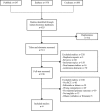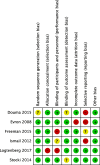Remifentanil patient-controlled versus epidural analgesia on intrapartum maternal fever: a systematic review and meta-analysis
- PMID: 32164593
- PMCID: PMC7069013
- DOI: 10.1186/s12884-020-2800-y
Remifentanil patient-controlled versus epidural analgesia on intrapartum maternal fever: a systematic review and meta-analysis
Abstract
Background: Intravenous remifentanil patient-controlled analgesia (RPCA) is an alternative for epidural analgesia (EA) in labor pain relief. However, it remains unknown whether RPCA is superior to EA in decreasing the risk of intrapartum maternal fever during labor.
Methods: According to the Preferred Reporting Items for Systematic Reviews and Meta-Analyses (PRISMA) guidelines, a systematic review and meta-analysis was performed by searching PubMed, EMBASE and the Cochrane Central Register of Controlled Trials from inception to April 2019. All randomized controlled trials (RCTs) investigating the risk of intrapartum maternal fever with RPCA compared with EA alone or EA in combination with spinal analgesia during labor were included.
Results: A total of 825 studies were screened, and 6 RCTs including 3341 patients were identified. Compared with EA, RPCA was associated with a significantly lower incidence of intrapartum maternal fever (risk ratio [RR] 0.48, P = 0.02, I2 = 49%) during labor analgesia. After excluding 2 trials via the heterogeneity analysis, there was no difference in the incidence of intrapartum fever between patients receiving RPCA and those receiving EA. Satisfaction with pain relief during labor was lower in the RPCA group than that in the EA group (- 10.6 [13.87, - 7.44], P < 0.00001, I2 = 0%). The incidence of respiratory depression was significantly greater in the RPCA group than that in the EA group (risk ratio 2.86 [1.65, 4.96], P = 0.0002, I2 = 58%). The incidence of Apgar scores < 7 at 5 min in the RPCA group was equivalent to that in the EA group.
Conclusion: There is no solid evidence to illustrate that the incidence of intrapartum maternal fever is lower in patients receiving intravenous RPCA than in patients receiving EA.
Keywords: Remifentanil, Epidural, Fever, Labor, Pain.
Conflict of interest statement
No external funding and no competing interests are declared.
Figures




References
-
- White A, Olson D, Messacar K. A state-wide assessment of the association between epidural analgesia, maternal fever and neonatal antibiotics in Colorado, 2007-2012. Arch Dis Child Fetal Neonatal Ed. 2017;102(2) F120-F5. - PubMed
Publication types
MeSH terms
Substances
LinkOut - more resources
Full Text Sources
Miscellaneous

